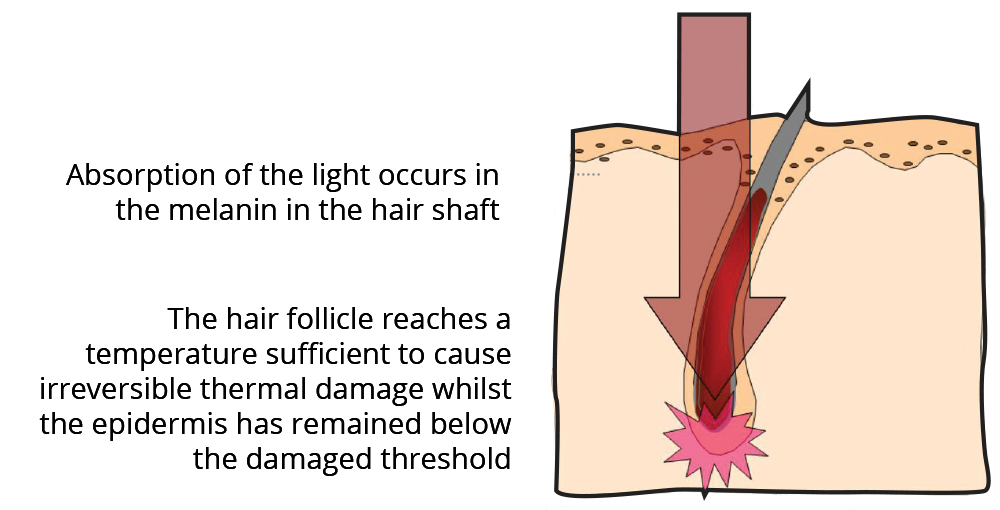Safe and effective solutions for unwanted hair. Proven to work on all areas of the body
Traditional methods such as waxing, shaving, and depilatory cream application are time consuming and can only offer short-term results. Intense Pulsed Light and Nd:YAG laser hair removal treatments combine scientific hair removal technology to provide safe and effective solutions for hair reduction.
 How do IPL and ND:YAG laser treatments work?
How do IPL and ND:YAG laser treatments work?
Both IPL and Nd:YAG laser treatments work on the same principle to treat hair, the treatment relies on absorption of melanin in the hair follicle. The system transmits a light to the treatment area which is a beam of energy that passes through the skin to the hair follicle. The melanin in the hair absorbs this energy which transforms into heat disabling the hair follicle preventing the growth of new hair. Each hair follicle has an individual growth cycle and to achieve unwanted hair reduction it is essential to treat the hair when in the growing stage. There are many factors that influence hair growth; age, metabolism, hormones, medication etc. An in-depth consultation with your hair removal specialist will be carried out before a treatment programme can proceed to assess your personal needs followed with a patch test to determine skin response.
Which do I choose Laser or IPL?
Both treatments have been available commercially since the mid 90's. It can be confusing to understand the difference between Laser and IPL therapy. The main difference lies in the technology that each uses to generate light as well as the different properties of the light being used.
- Lasers produce a single wavelength of light which makes them far more precise and able to select and target dark coarse hairs whilst leaving the surrounding skin undamaged. They are also safe for all skin colours.
- IPL produces a broad spectrum of light with a range of wavelengths. Only a few of these wavelengths will actually reach the intended target as the light is multidirectional and therefore less precise. This also means with IPL only lighter skin types can be treated.
IPL's are NOT lasers and laser technology is simply much more effective and achieves substantially better results than IPL hair removal.
What does a treatment involve?
The Nd:YAG laser hair removal hand piece is held above the hair follicle and a beam of laser source is delivered to the individual hairs. For IPL hair removal the sapphire chilled hand piece is gently applied to the skin and pulses of intense light are applied to a group of hair follicles. At the time of treatments some hairs are removed however it can take up to two weeks for all treated hairs to disperse. It is important not to remove any hair by plucking, tweezing, waxing or depilatory cream four weeks prior to receiving an IPL and Nd:YAG laser hair removal treatment. This is to ensure that there is hair within the follicles to be destroyed by the light.
We also advise that post treatment an SPF sunscreen is applied to the treated area(s) to limit sun exposure for a few weeks.
Can all hairs be treated?
Effective results have been achieved on all skin types (including darker skin types) as the treatment relies on the absorption of light in the hair pigment (melanin). The treatment is unlikely to work for very blond, white or grey hair. The technology is supported by worldwide clinical research studies with proven results.

How many treatments are needed?
The hair removal treatment will only destroy hair follicles that are in the growing stage. At any one moment hair follicles are either resting or dormant, this is why it is necessary to have repeated treatment sessions until all hair follicles have been through the growing stage. A course of treatments will treat hairs when they re-enter the growing stage. Recommended courses of 6-12 treatments may be required; however this does depend on many factors including skin and hair type, ethnic background, hormonal balance along with skin sensitivity. It is not possible to define how many treatments an individual will require.

